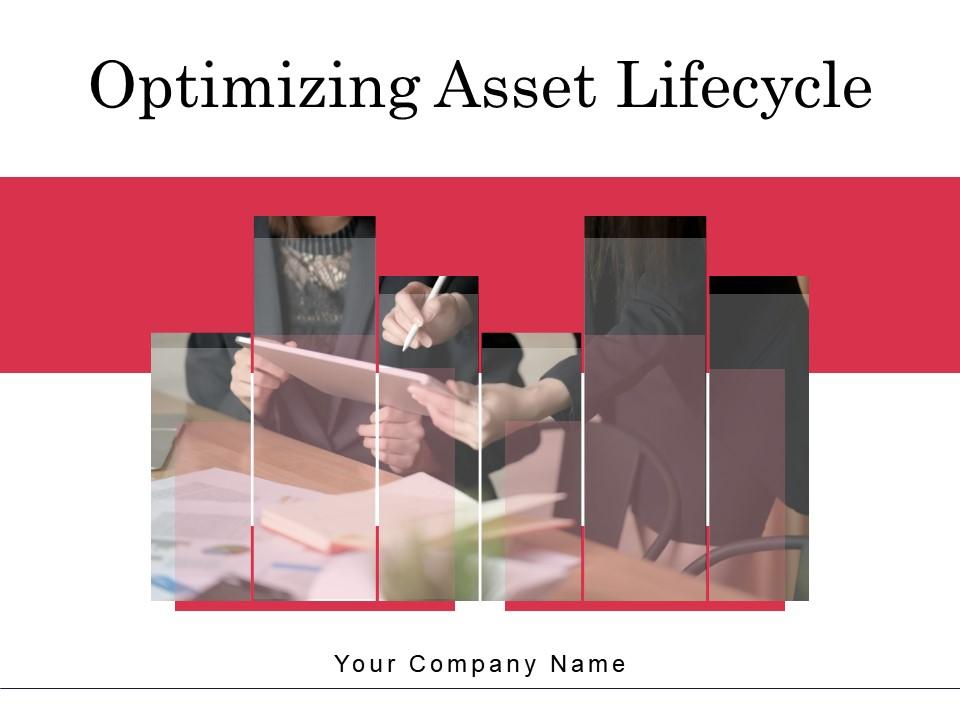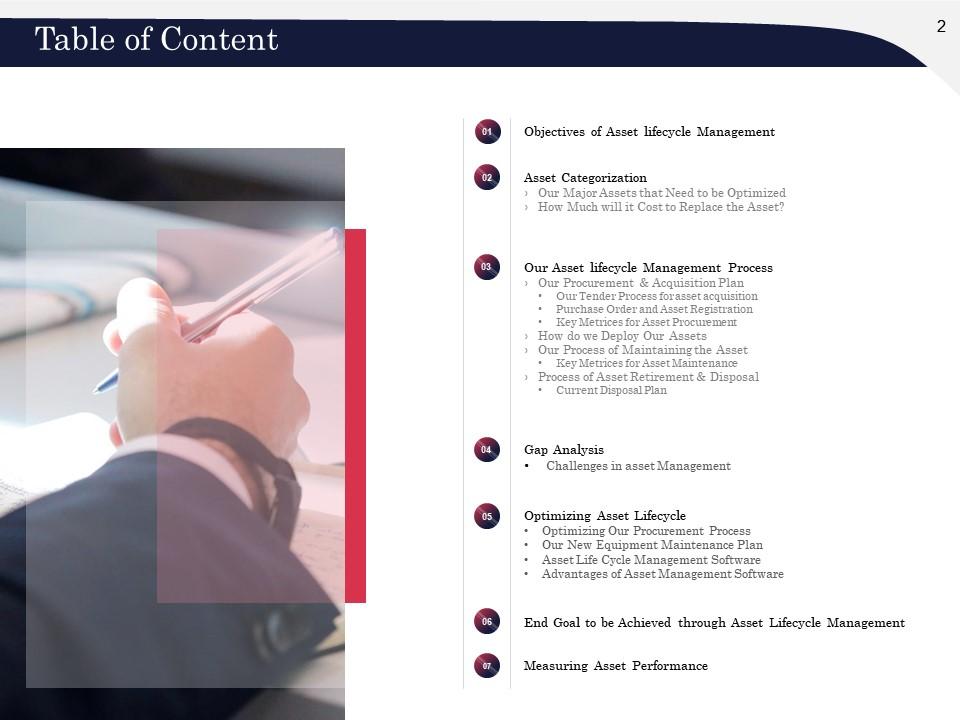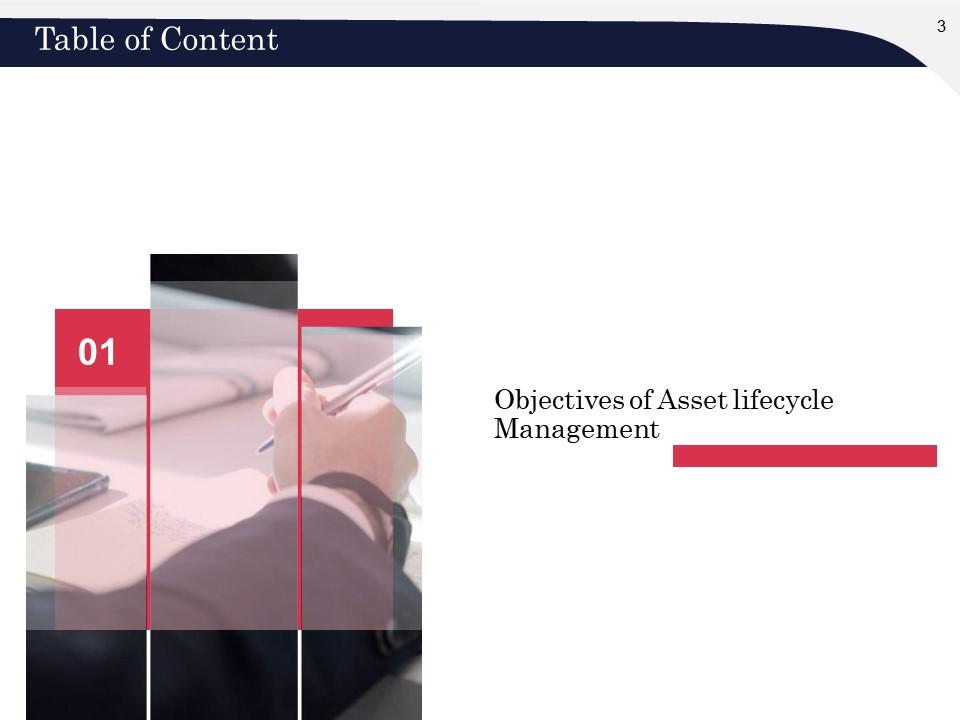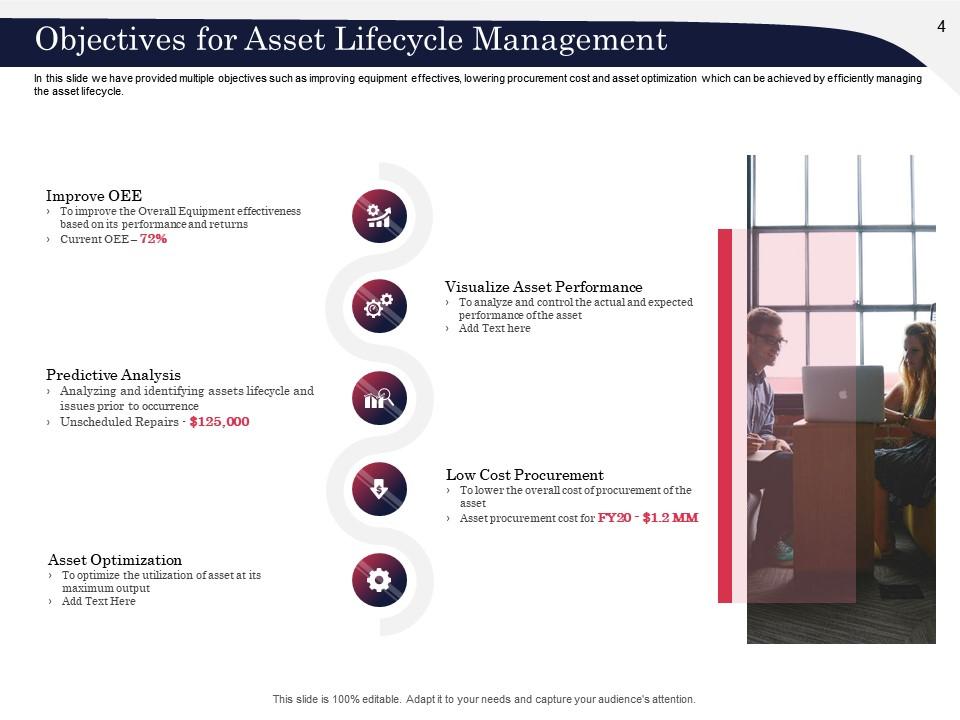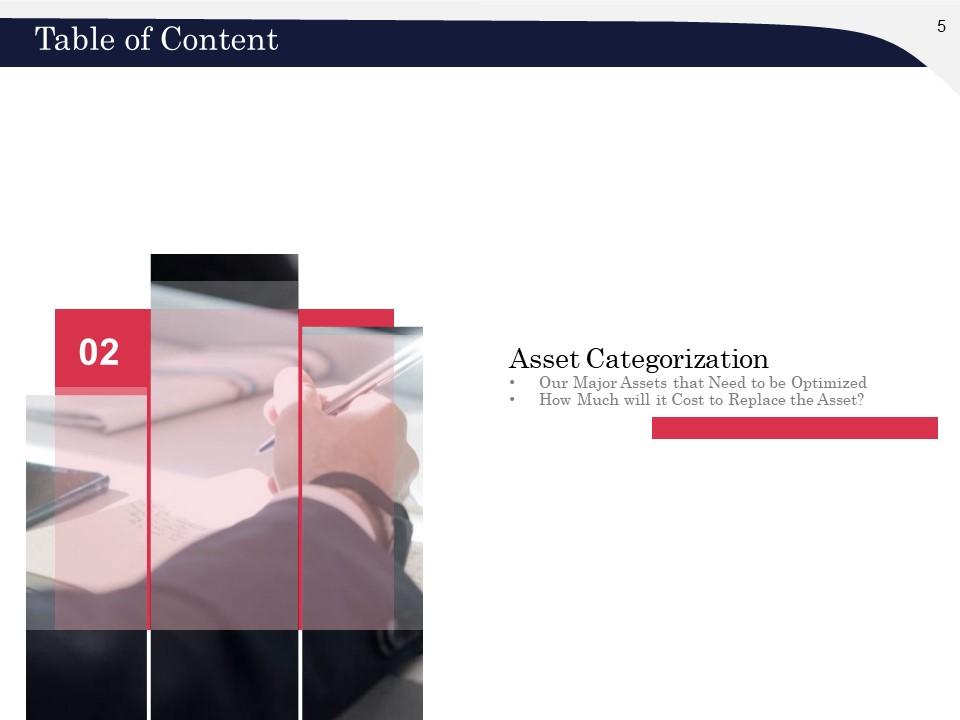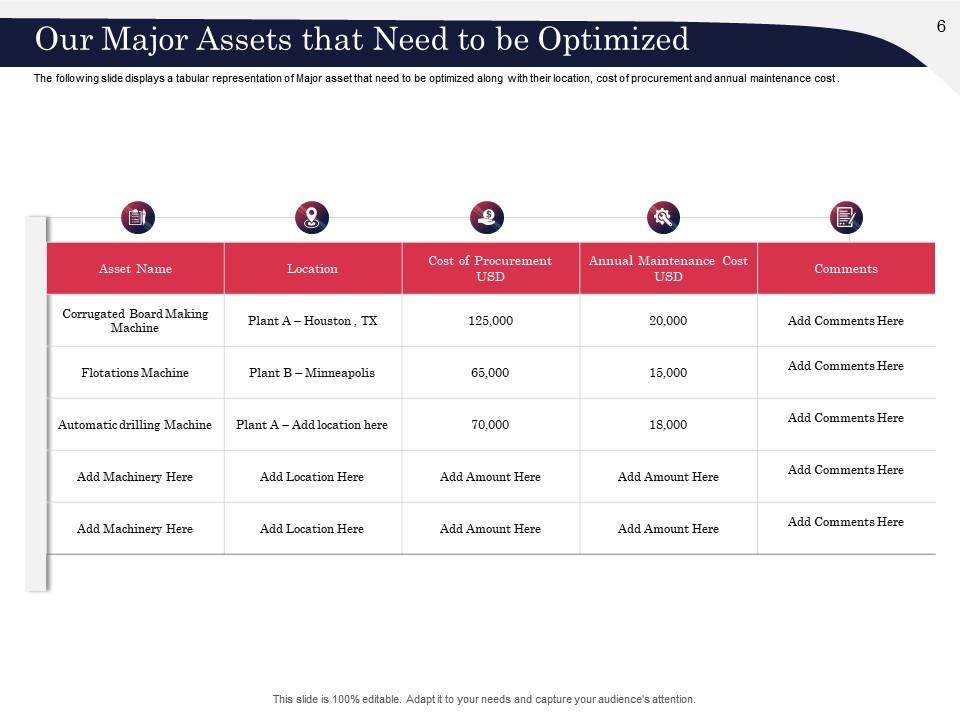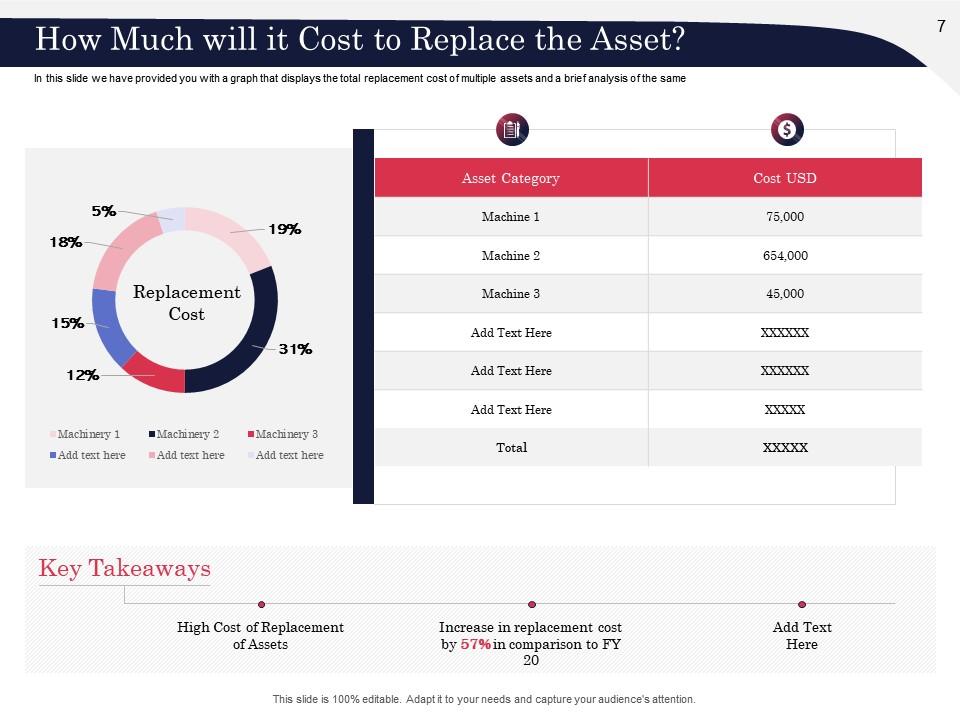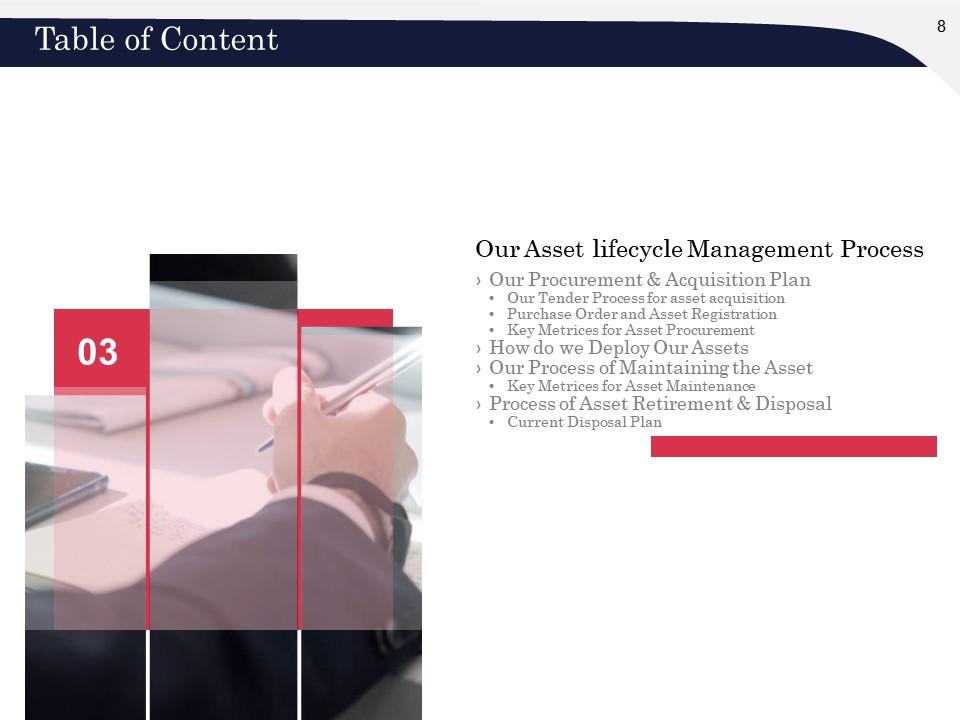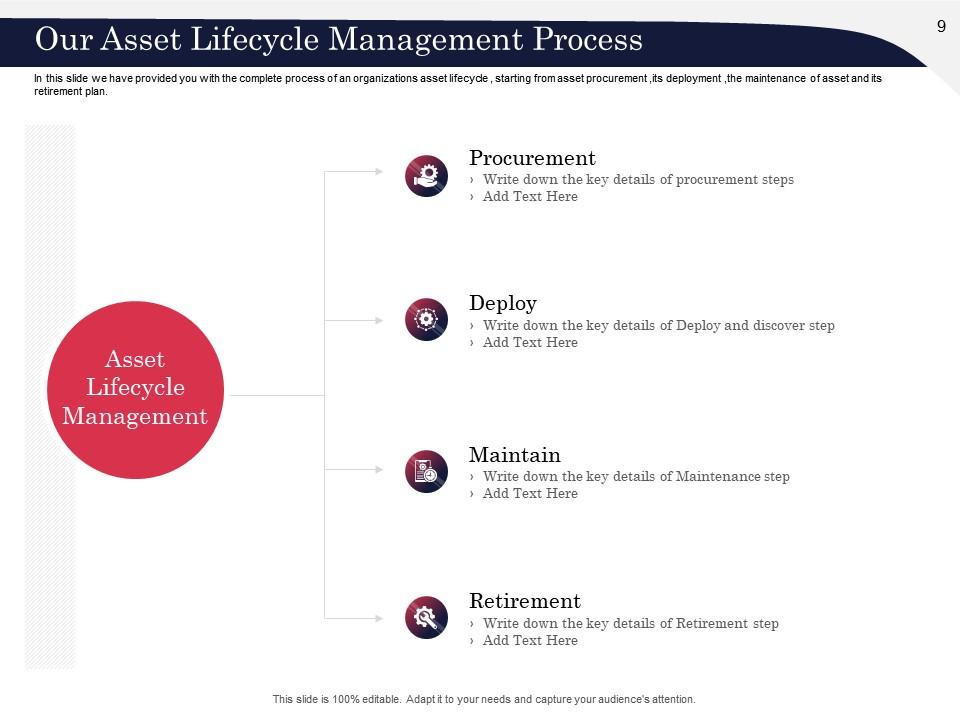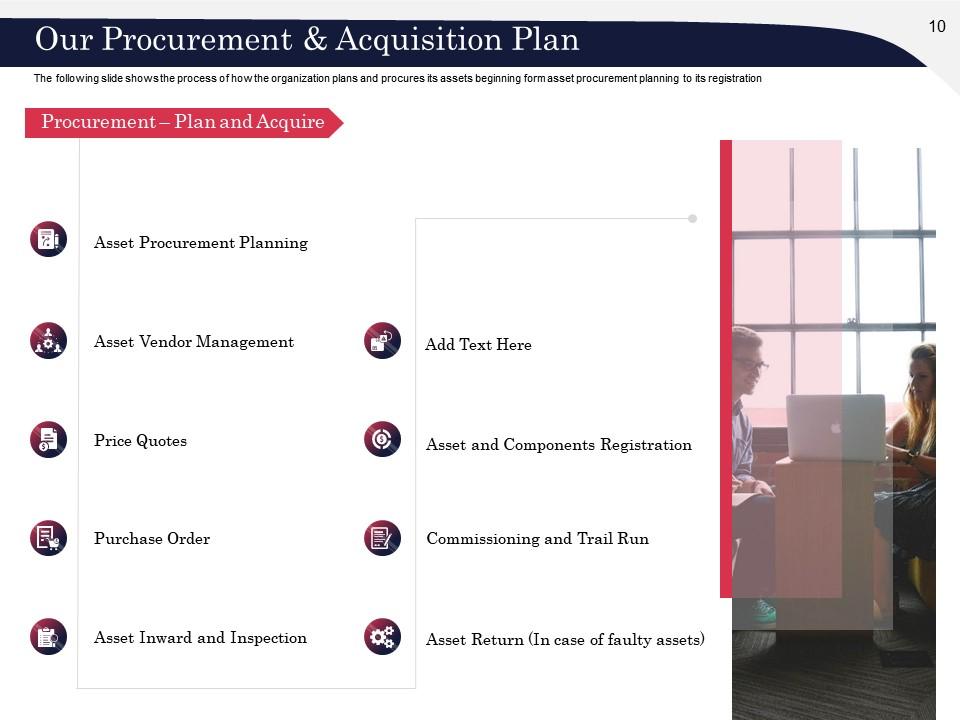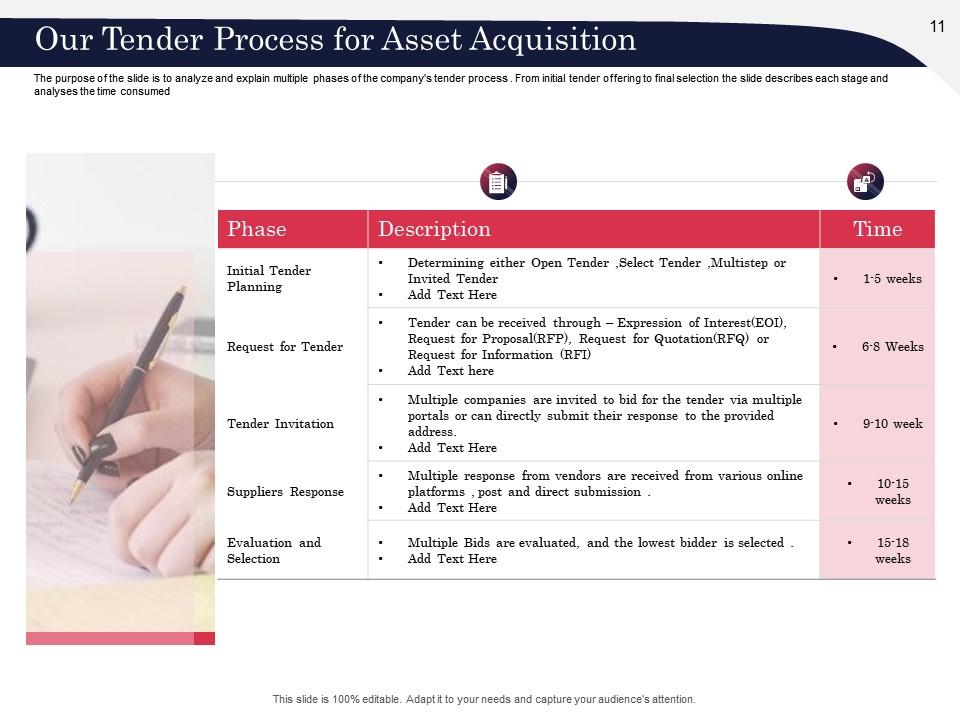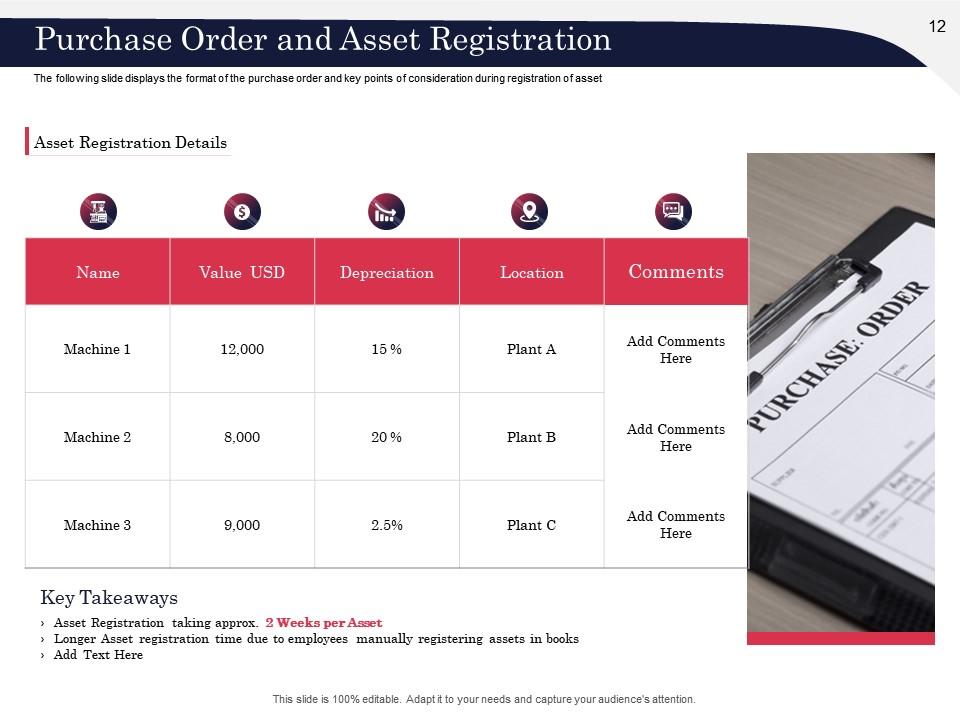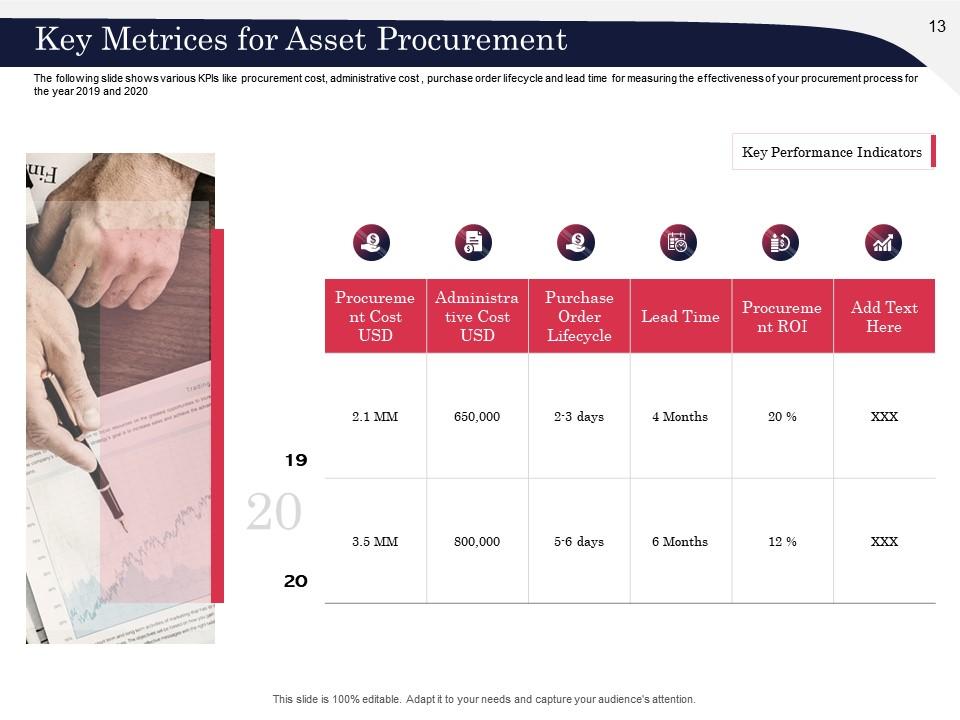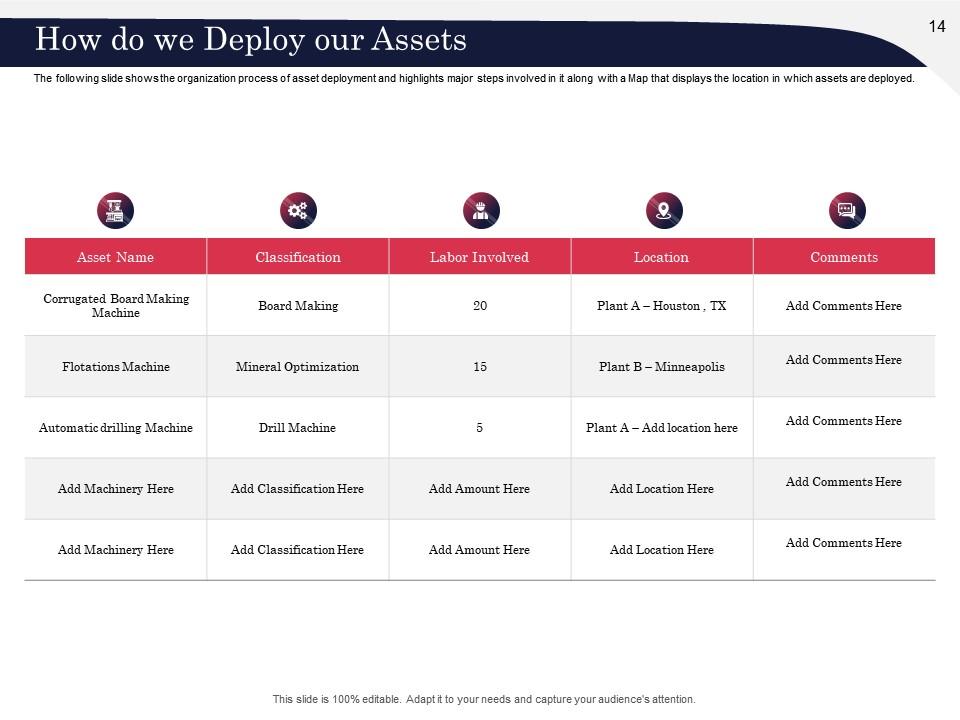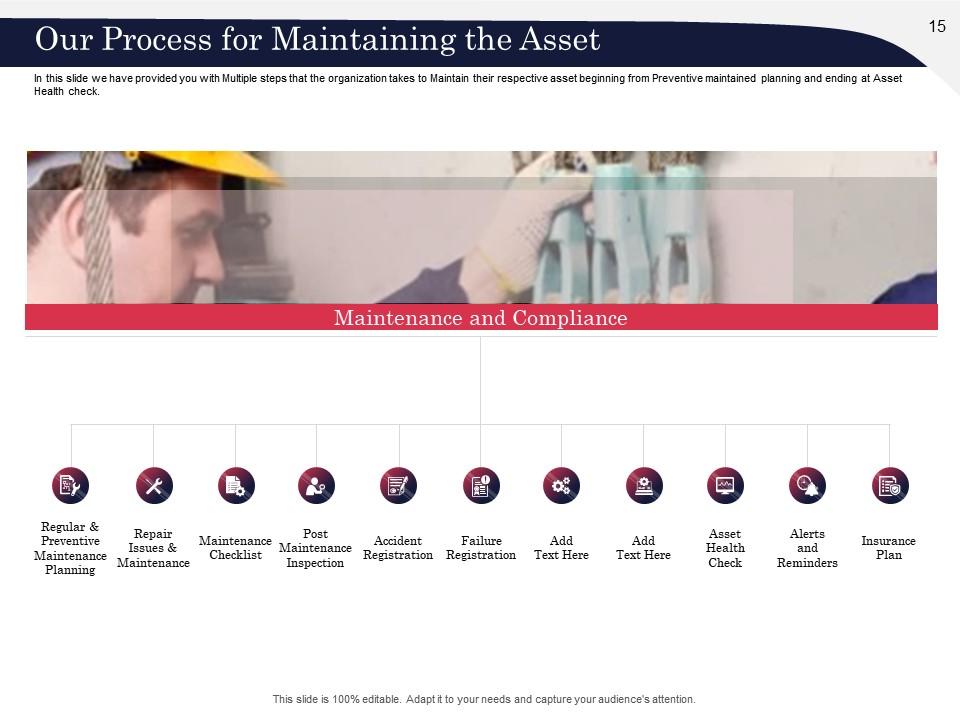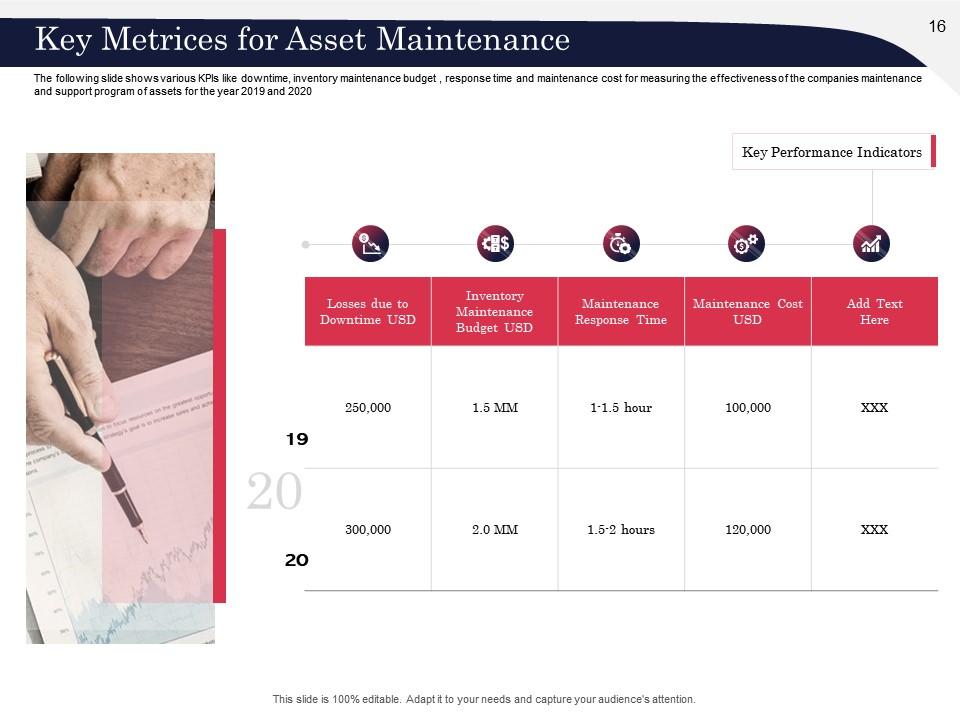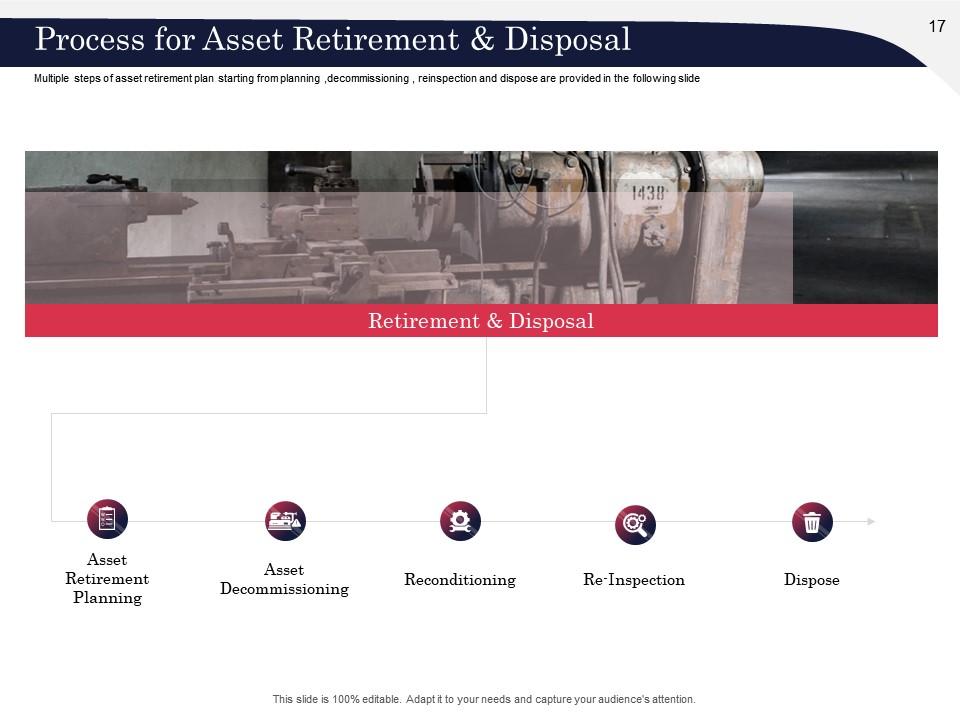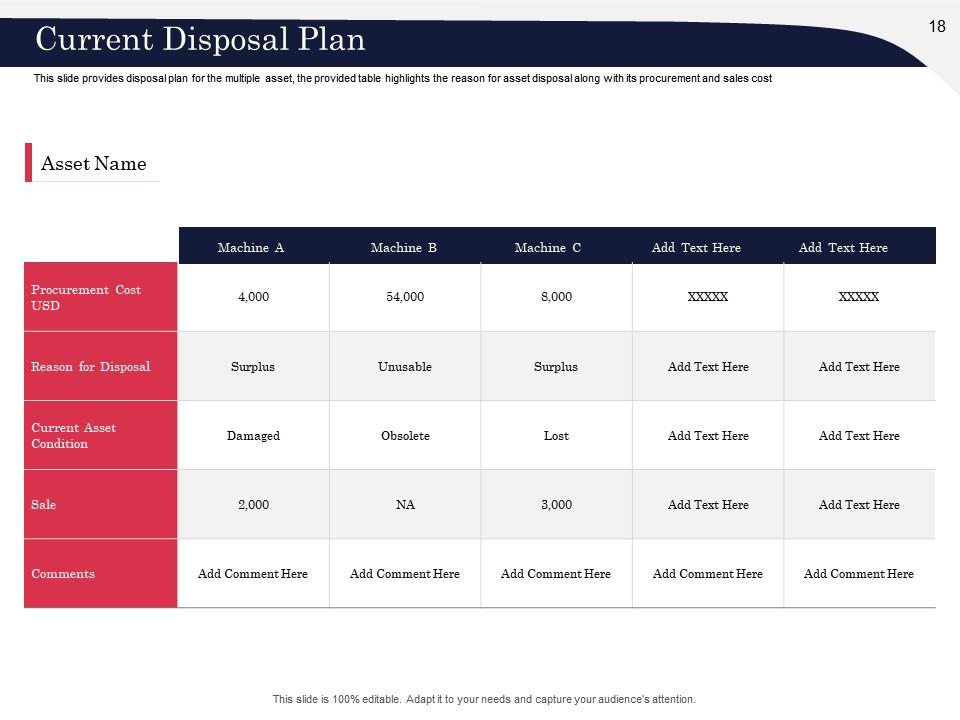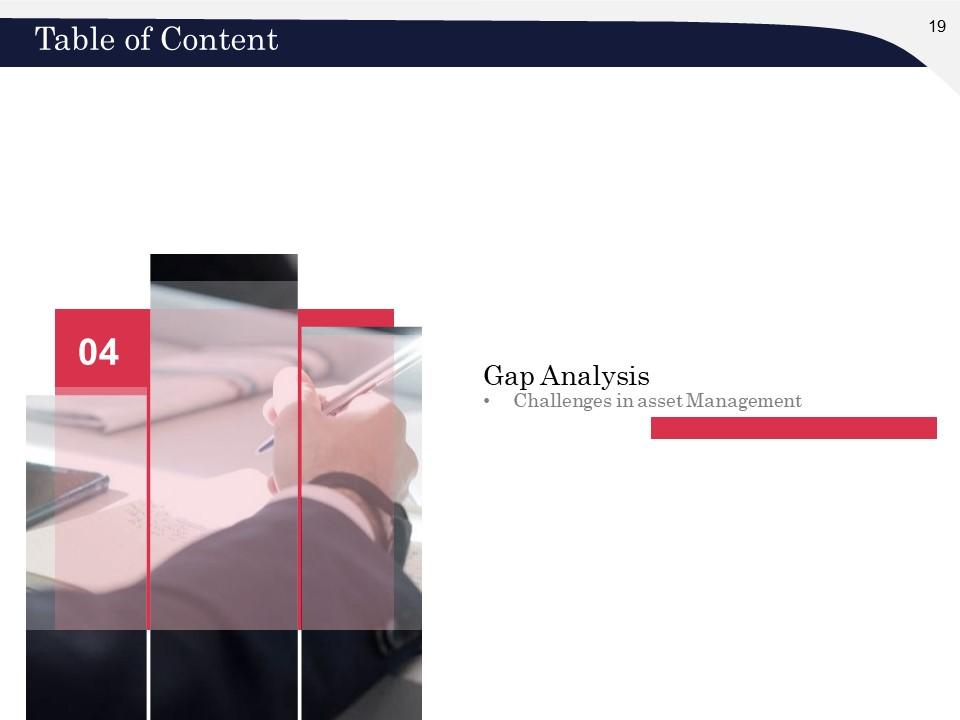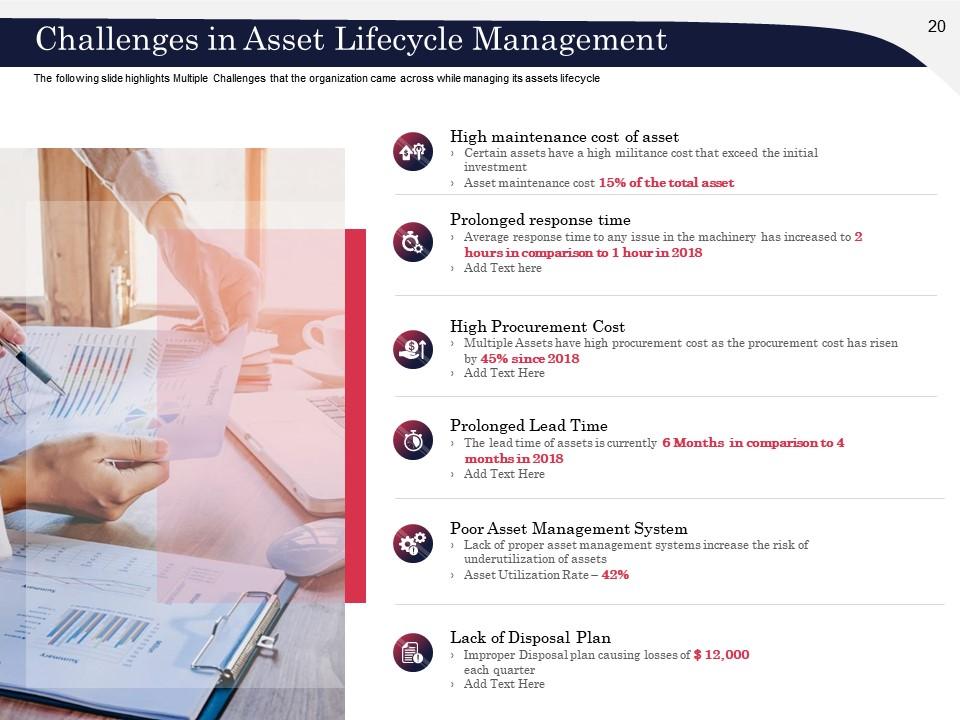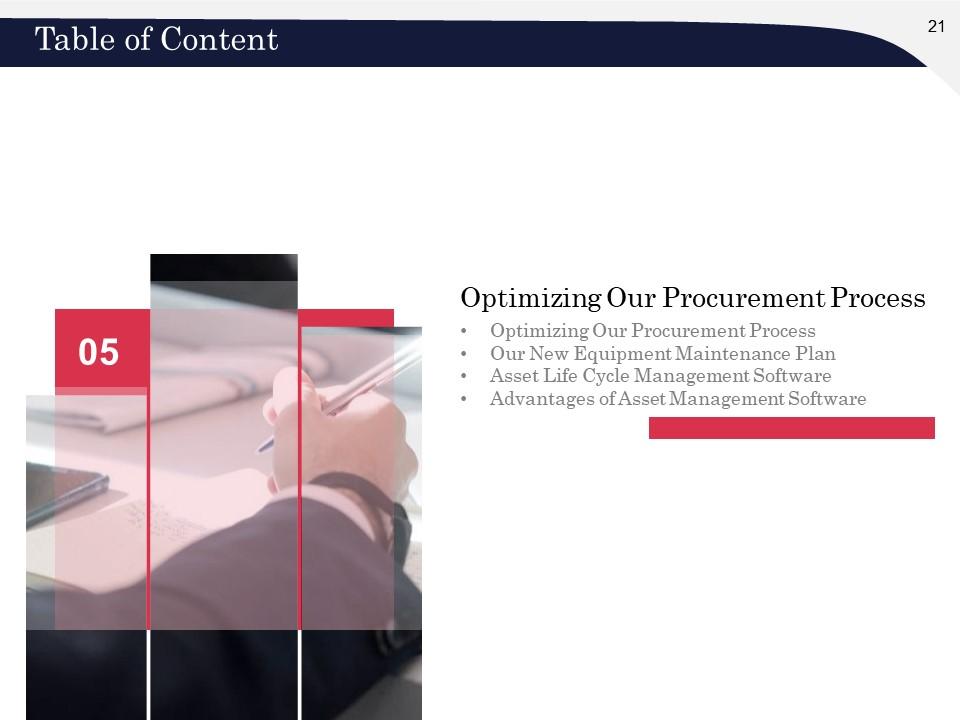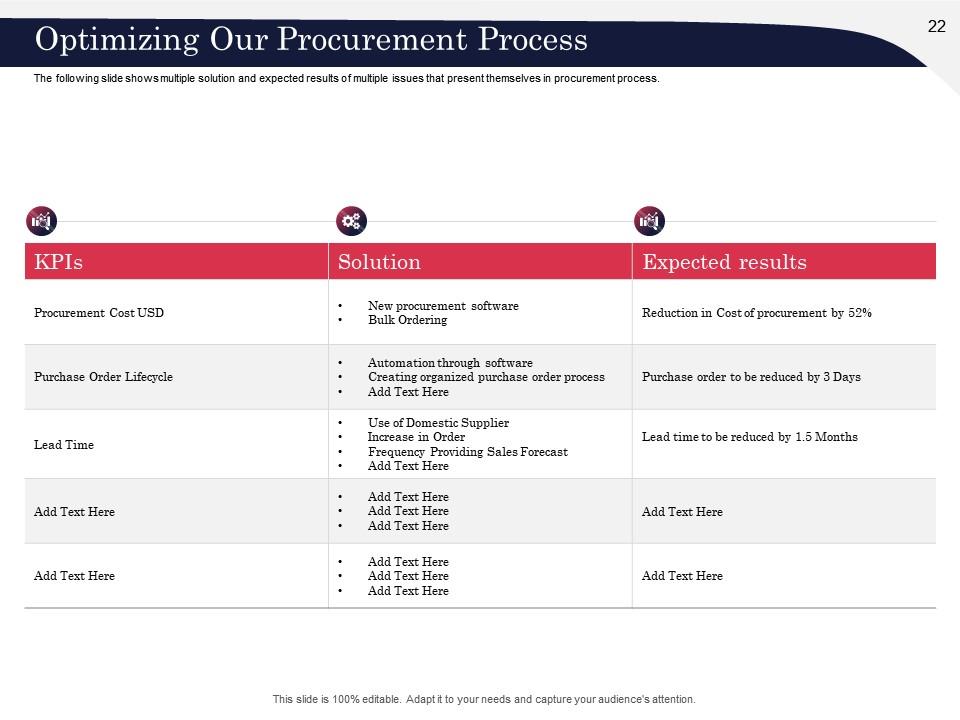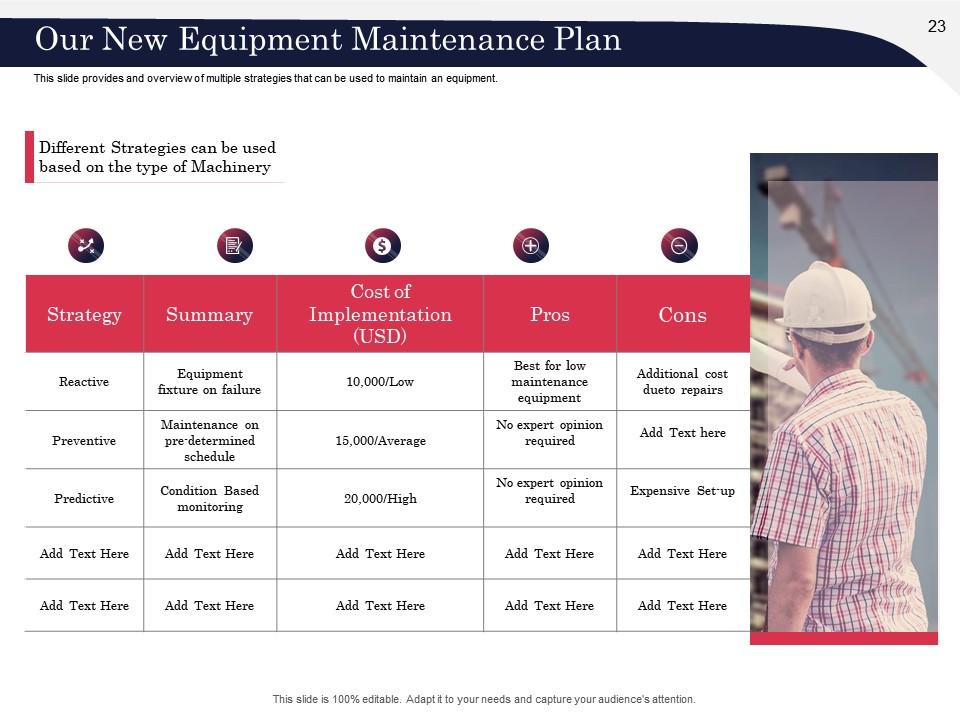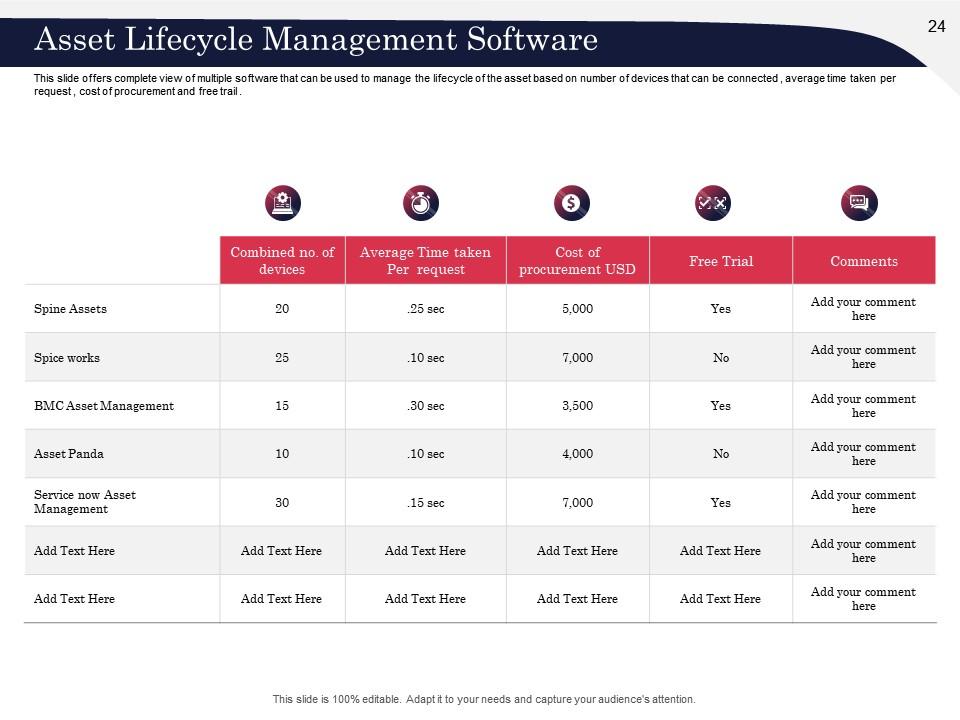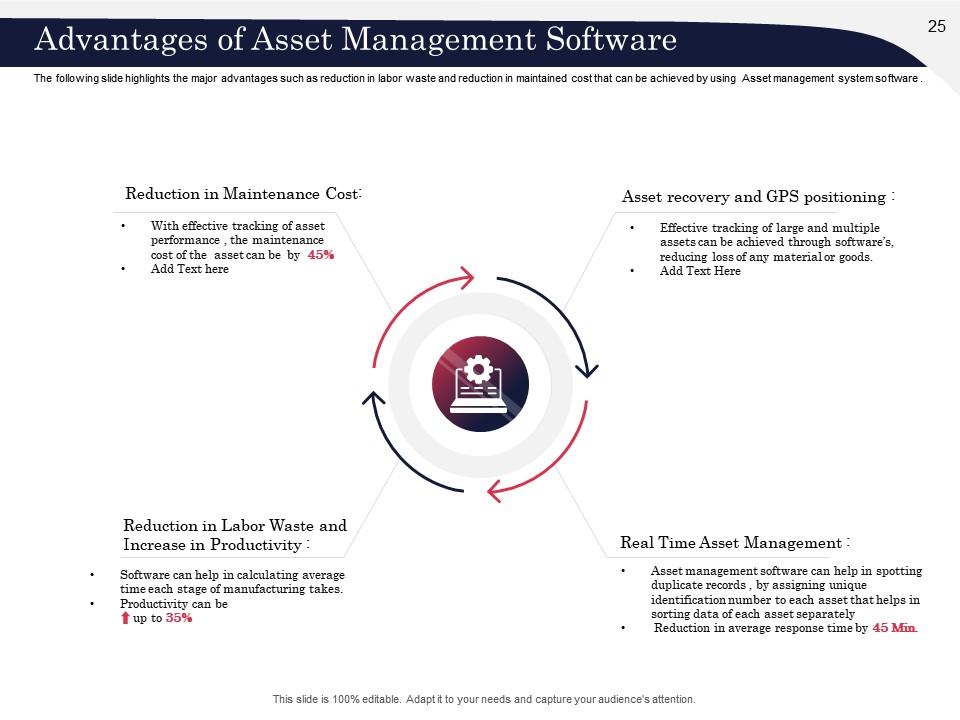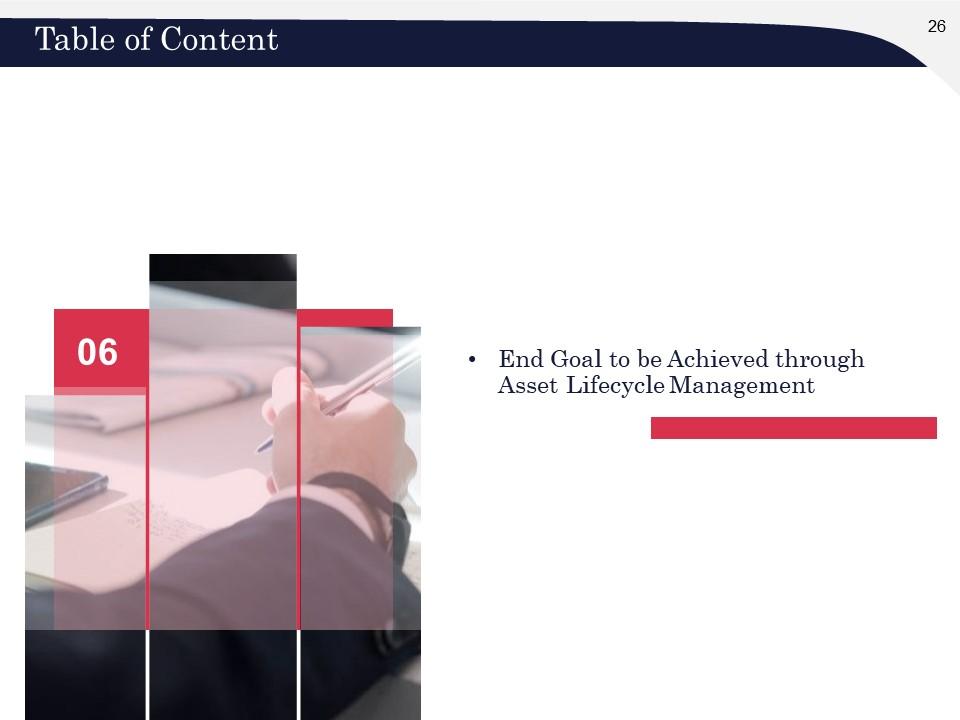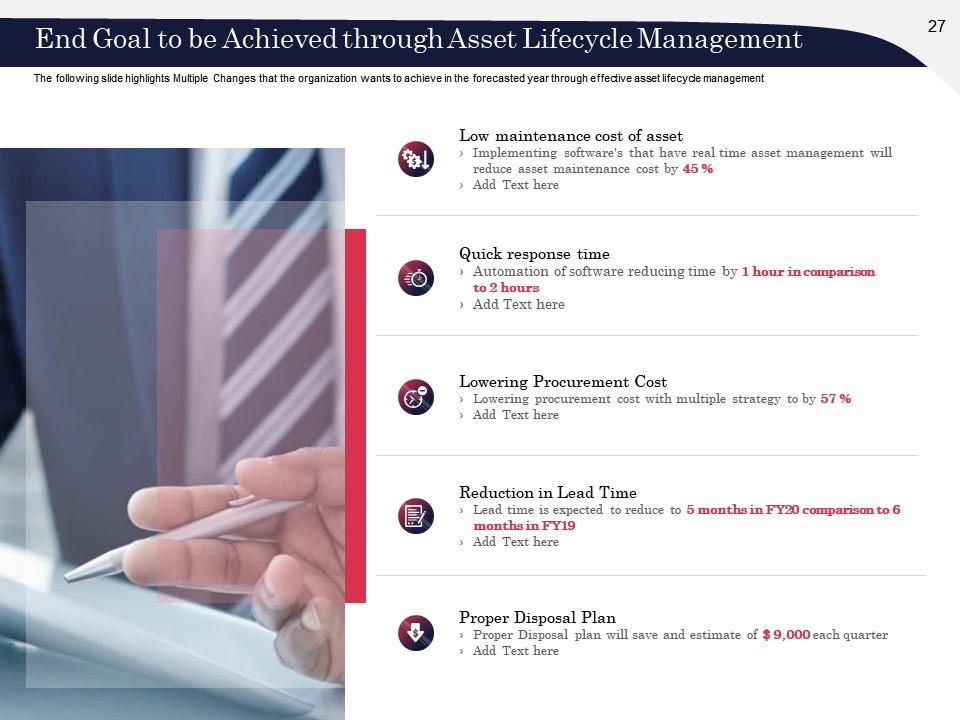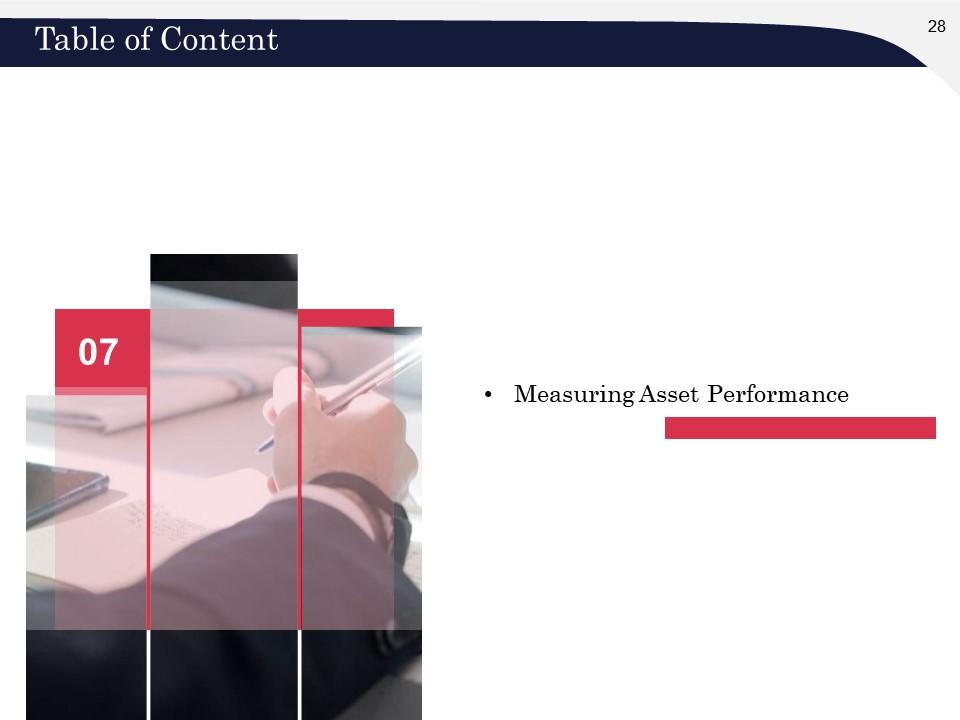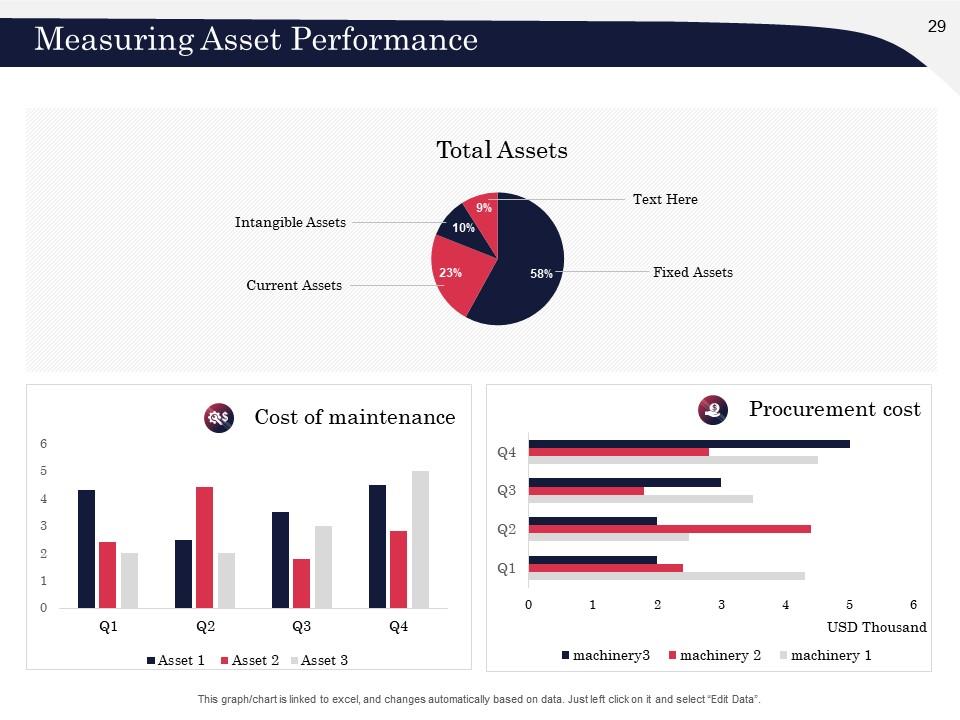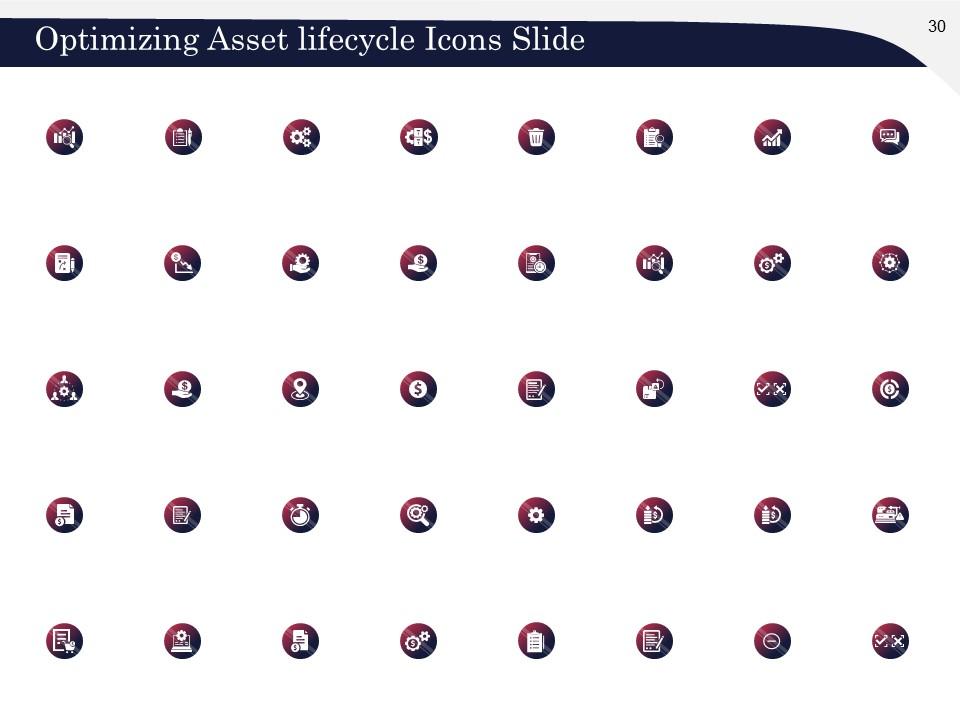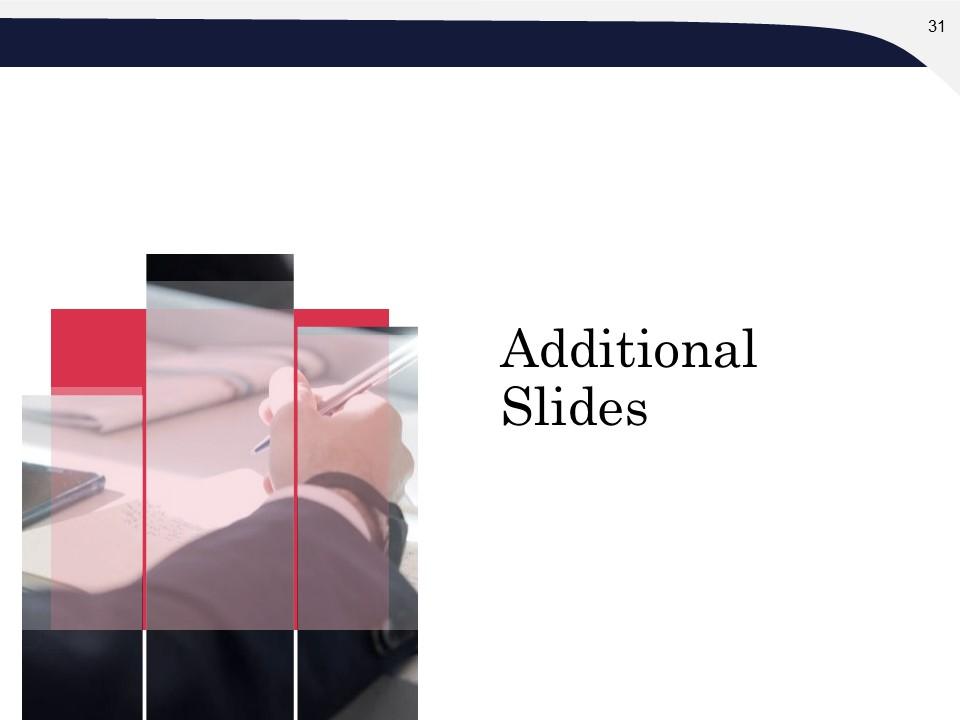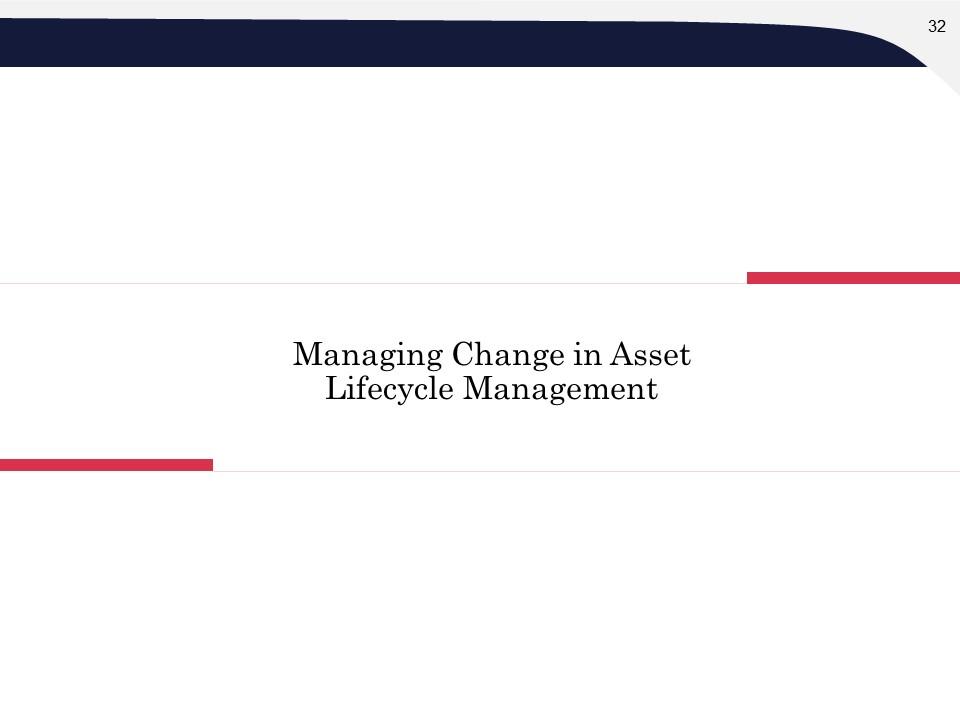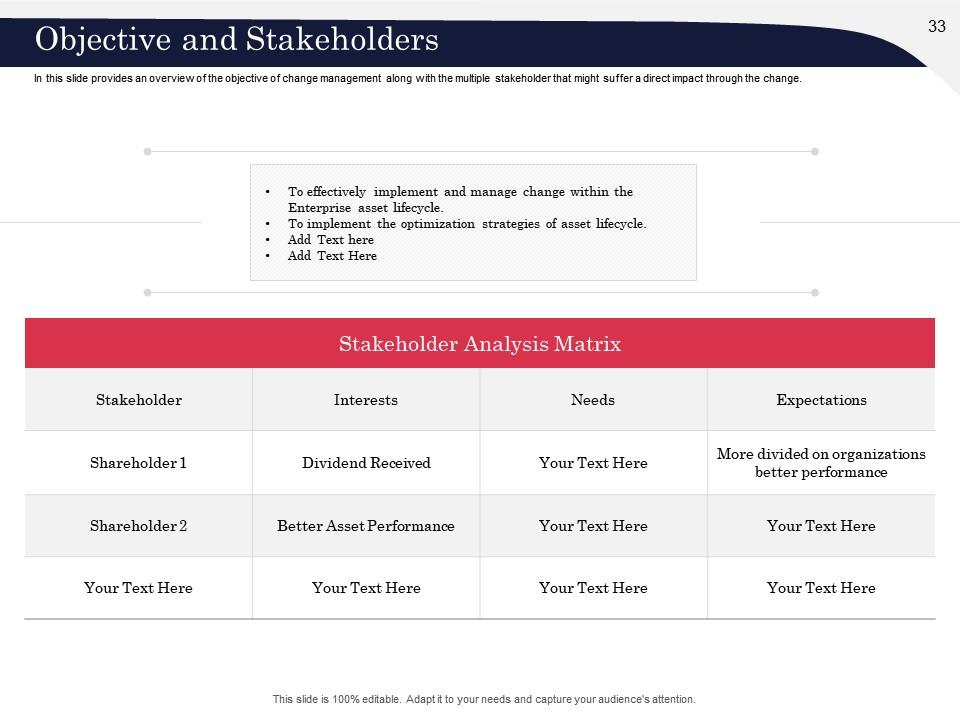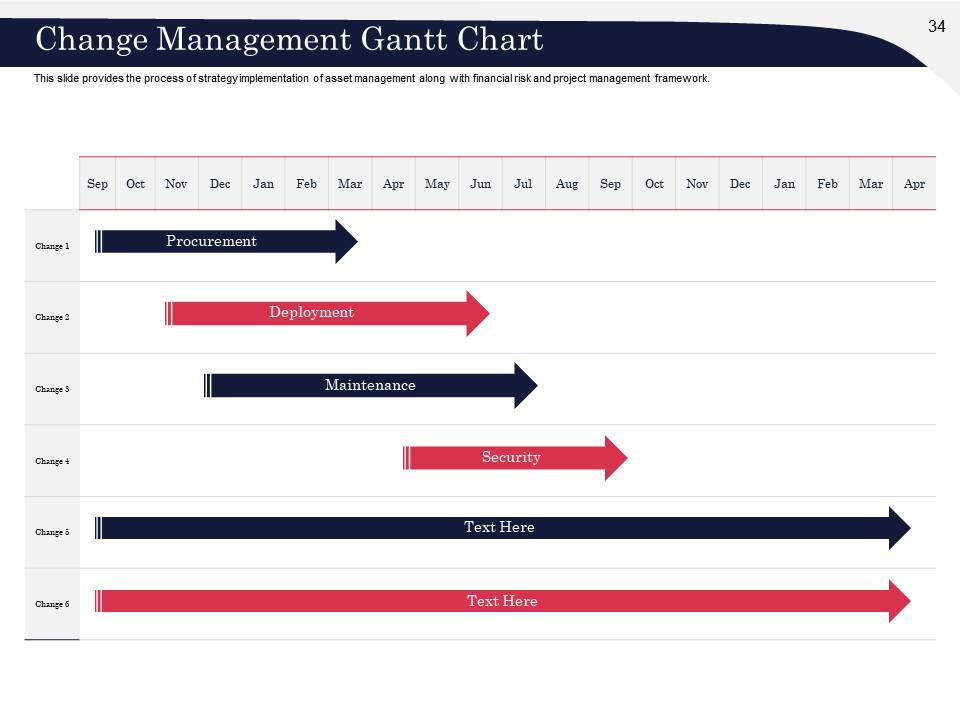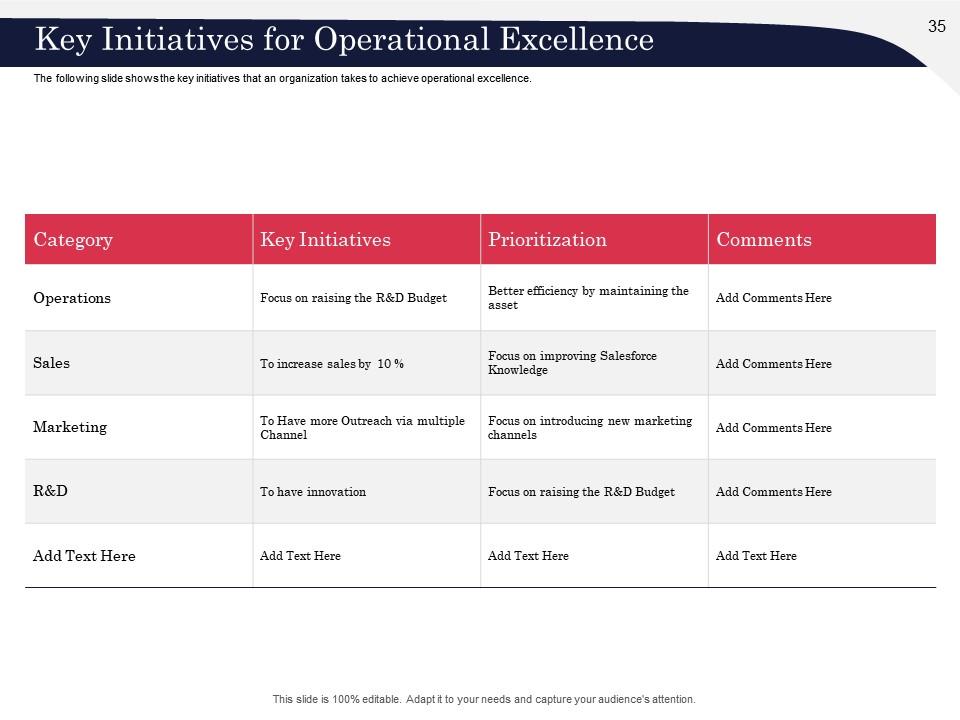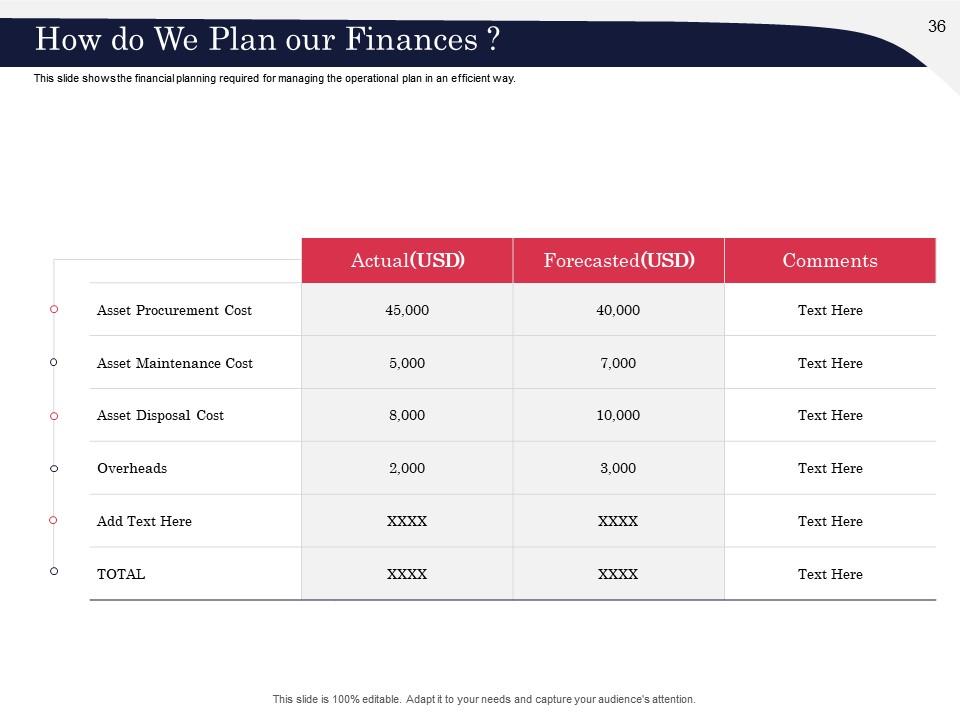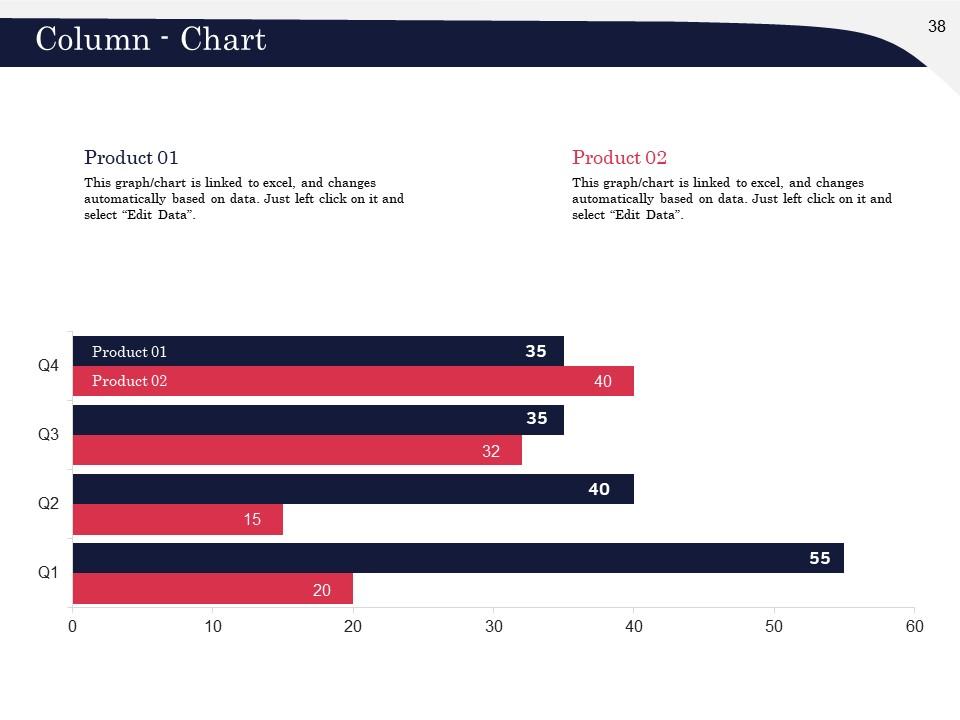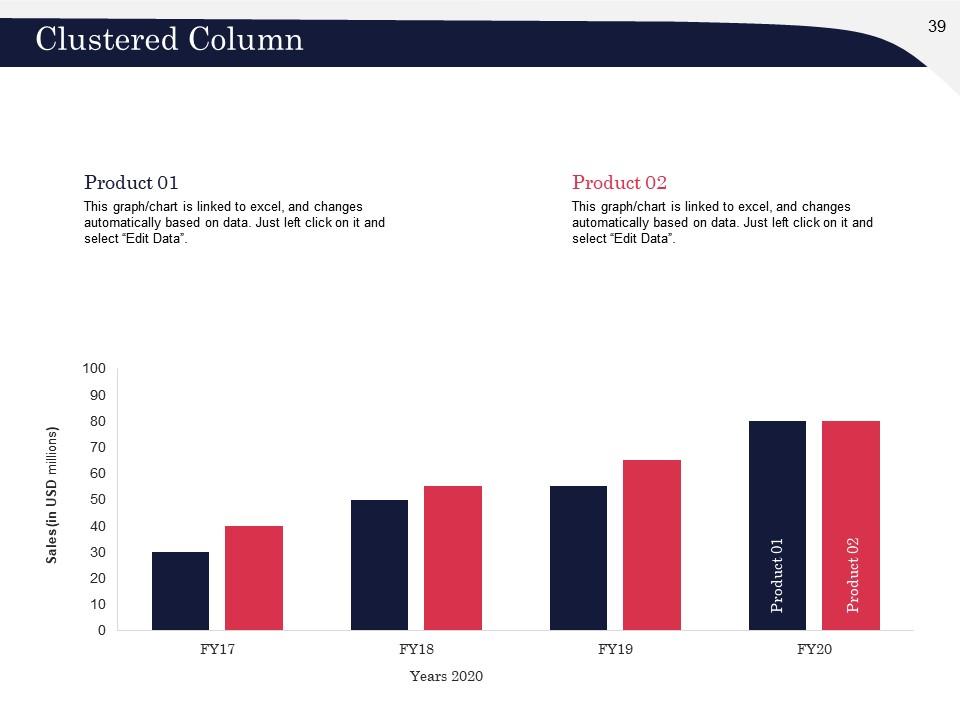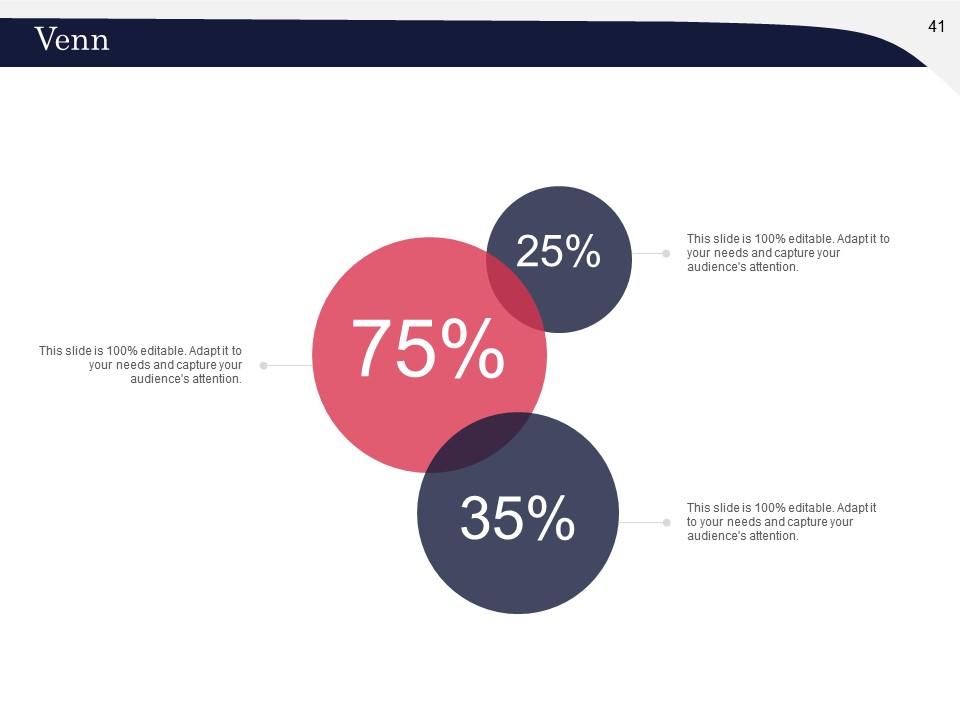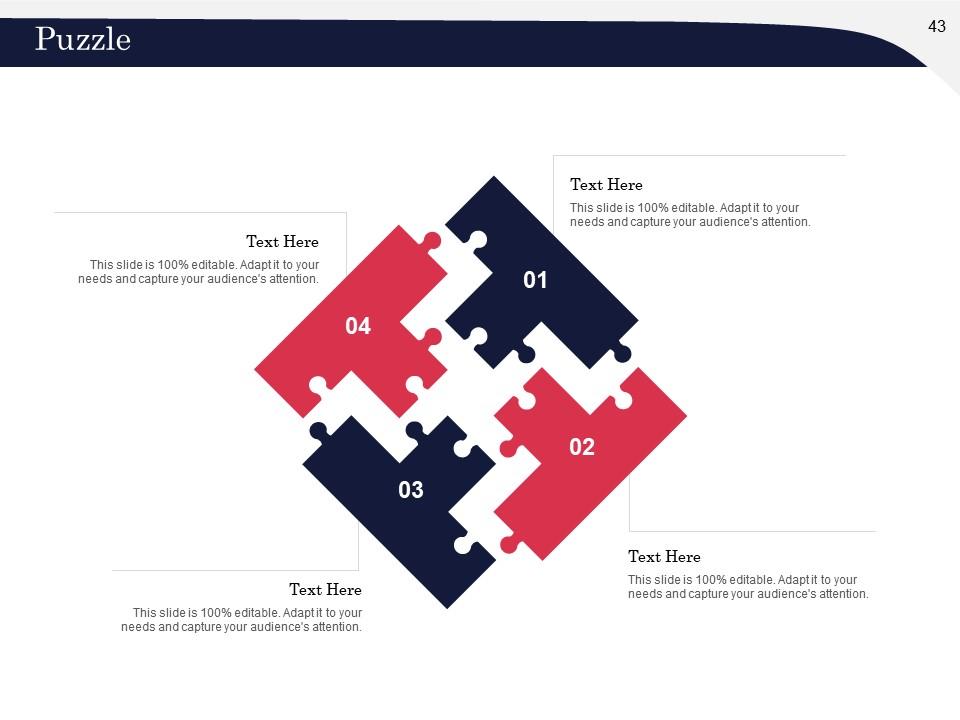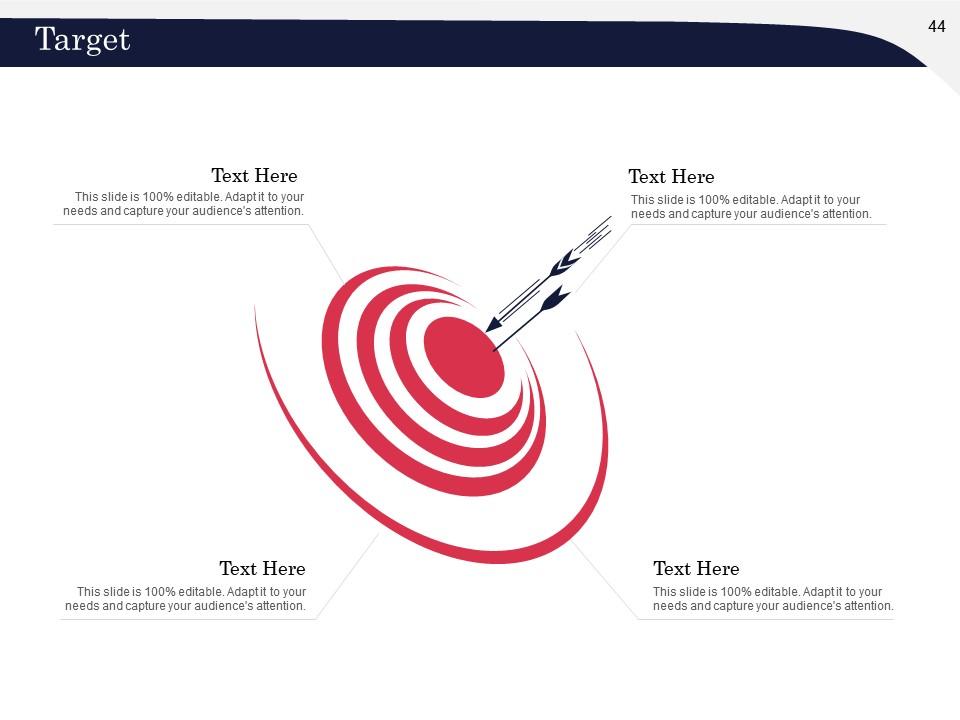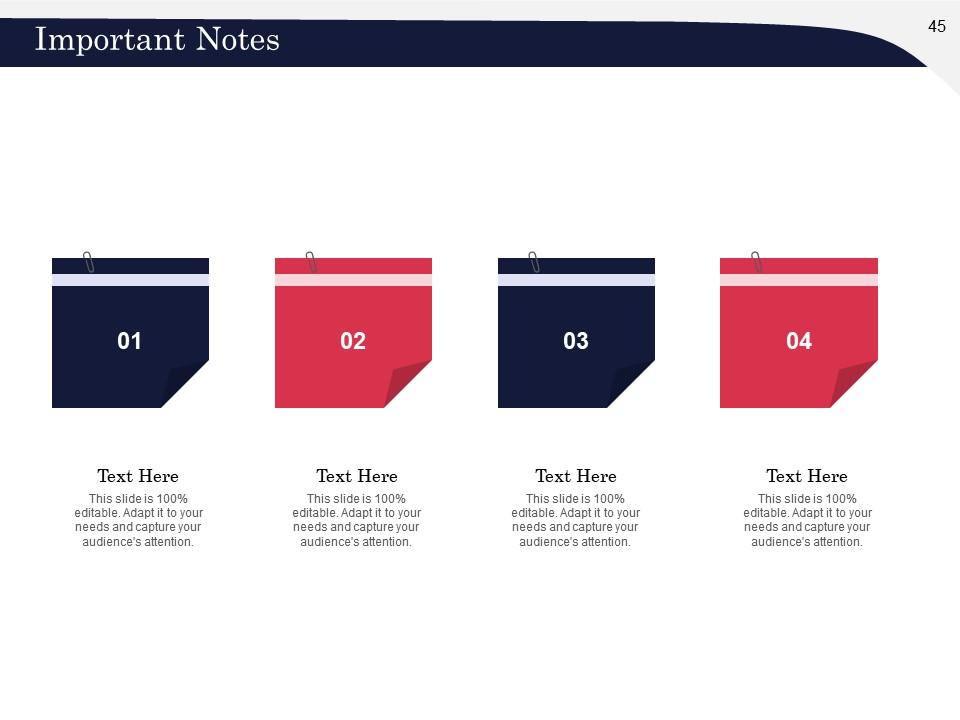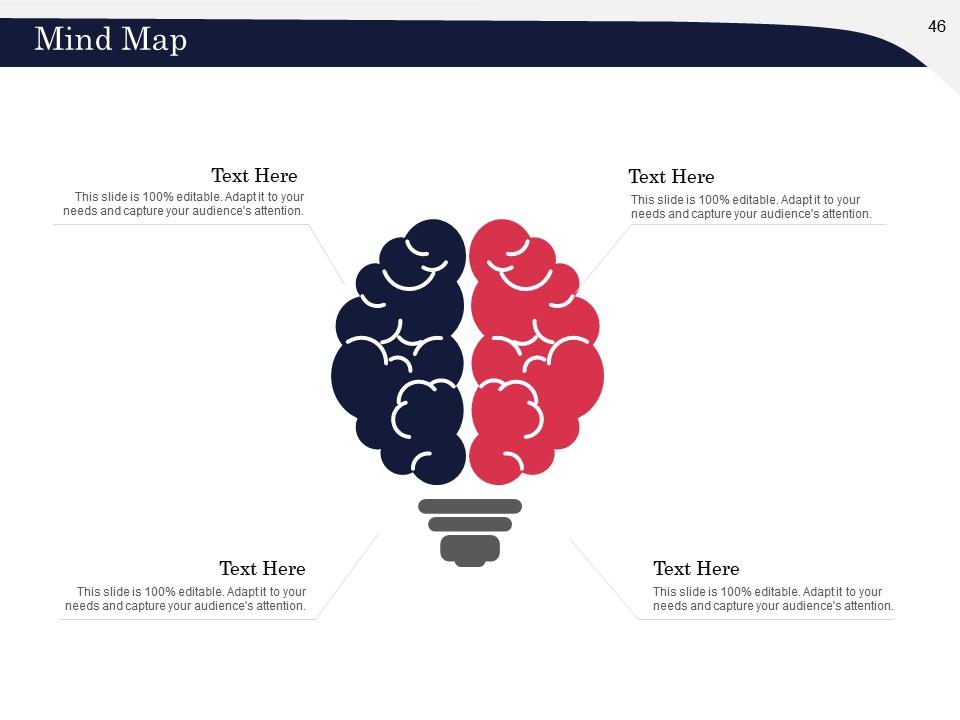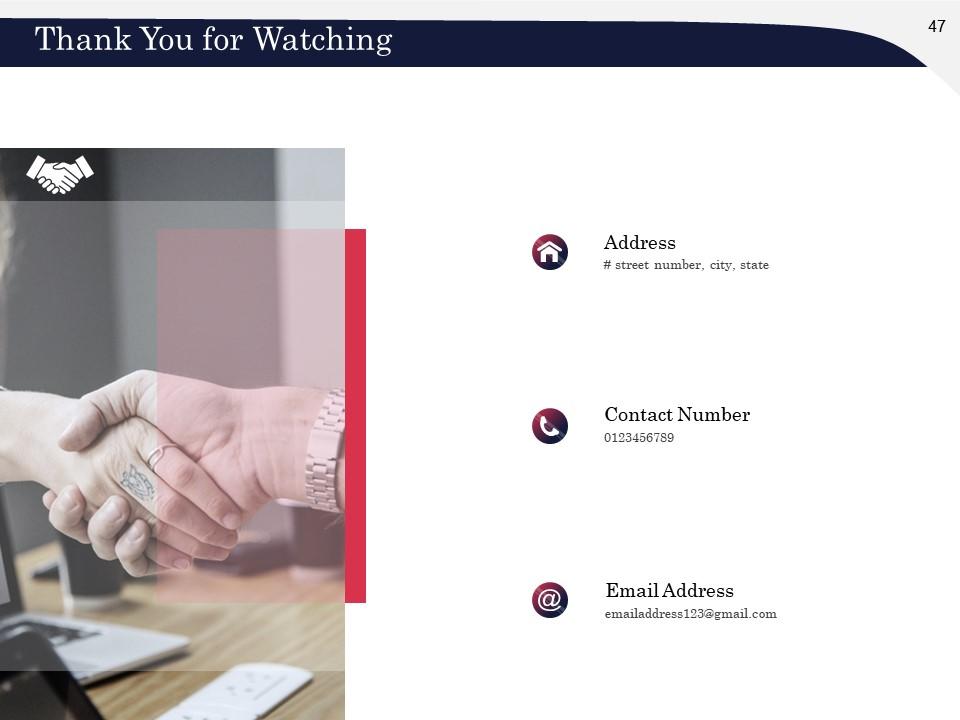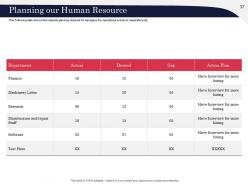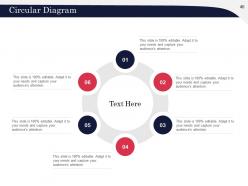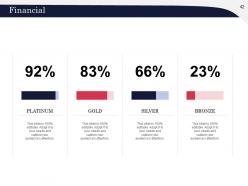Optimizing asset lifecycle powerpoint presentation slides
Improve the overall effectiveness of your business assets and minimize their failure risk by using our Optimizing Asset Lifecycle PowerPoint Presentation Slides. Use this asset reliability PPT template and showcase the objects like the reduction of procurement cost, control over the actual performance of the asset, and its optimization. The strategic management PowerPoint slideshow helps your business to categorize the assets and implement an asset lifecycle management process. You can further classify the steps of the management process like procurement, deployment, maintenance and retirement with this asset cost affecting PPT design. The gap analysis PowerPoint presentation also elucidates the multiple challenges that the organization faces while managing the lifecycle of its assets like high maintenance cost, prolonged response time, prolonged lead time, poor asset management system, and lack of disposal plan. Optimize the procurement process by developing a new management plan and software as discussed in the asset refinement PPT graphic. The disposal plan PowerPoint layout also helps you to display the end goals to be achieved and measurement of asset performance.
Improve the overall effectiveness of your business assets and minimize their failure risk by using our Optimizing Asset Lif..
- Google Slides is a new FREE Presentation software from Google.
- All our content is 100% compatible with Google Slides.
- Just download our designs, and upload them to Google Slides and they will work automatically.
- Amaze your audience with SlideTeam and Google Slides.
-
Want Changes to This PPT Slide? Check out our Presentation Design Services
- WideScreen Aspect ratio is becoming a very popular format. When you download this product, the downloaded ZIP will contain this product in both standard and widescreen format.
-

- Some older products that we have may only be in standard format, but they can easily be converted to widescreen.
- To do this, please open the SlideTeam product in Powerpoint, and go to
- Design ( On the top bar) -> Page Setup -> and select "On-screen Show (16:9)” in the drop down for "Slides Sized for".
- The slide or theme will change to widescreen, and all graphics will adjust automatically. You can similarly convert our content to any other desired screen aspect ratio.
Compatible With Google Slides

Get This In WideScreen
You must be logged in to download this presentation.
PowerPoint presentation slides
Presenting our Optimizing Asset Lifecycle PowerPoint Presentation Slides that are sure to impress executives, inspire team members, and other audiences. You can use the asset lifecycle PowerPoint design according to your company’s product information. We have used beautiful PowerPoint graphics, templates, icons, and diagrams. The content has been well researched by our excellent team of researchers. You can change the colour, fonts, texts, images without any hassle to suit your business needs. The PPT is available in both standard screen and widescreen aspect ratios. Download the presentation, enter your content in the placeholders, and present it with confidence!
People who downloaded this PowerPoint presentation also viewed the following :
Content of this Powerpoint Presentation
Slide 1: This slide introduces the Optimizing Asset Lifecycle. Add your company name here.
Slide 2: This slide contains the Table of Content. This includes Objectives of Asset lifecycle Management, Asset Categorization, Our Asset lifecycle Management Process, Gap Analysis, Optimizing Asset Lifecycle, Optimizing Our Procurement Process, End Goal to be Achieved through Asset Lifecycle Management, Measuring assets Performance.
Slide 3: This slide introduces the Objectives of Asset lifecycle Management.
Slide 4: This slide introduces the Objectives for Asset Lifecycle Management. This includes- Improve OEE, Predictive Analysis, Asset Optimization, Visualize Asset Performance, and Low-Cost Procurement.
Slide 5: This slide introduces Asset Categorization which includes Our Major Assets that Need to be Optimized and How Much Will it Cost to Replace the Asset?
Slide 6: This slide presents a tabulated representation of Our Major Assets that Need to be Optimized. These assets include asset name, location, cost of procurement (USD), and annual maintenance cost (USD).
Slide 7: This slide presents a table that shows How Much will it Cost to Replace the Asset? Its key takeaways are the high cost of replacement of assets and an increase in replacement cost by 57% in comparison to FY 20 among others.
Slide 8: This slide introduces Our Asset lifecycle Management Process. This includes Our Procurement & Acquisition Plan, How do we Deploy Our Assets, Our Process of Maintaining the Asset, and the Process of Asset Retirement & Disposal.
Slide 9: This slide introduces the Our Asset Lifecycle Management Process. It includes Procurement, Deploy, Maintain, and Retirement.
Slide 10: This slide presents the Procurement – Plan and Acquire. This includes Asset Procurement Planning, Asset Vendor Management, Price Quotes, Purchase Order, Asset Inward and Inspection, Commissioning and Trail Run, Asset and Components Registration, Asset Return (In case of faulty assets), Our Procurement & Acquisition Plan.
Slide 11: This slide presents the Our Tender Process for Asset Acquisition. It analyzes and explains multiple phases of the company's tender process which include initial tender planning, request for tender, tender invitation, suppliers response, and evaluation and selection.
Slide 12: This slide presents the Purchase Order and Asset Registration in the format of the purchase order and key points of consideration during the registration of assets. The key takeaways Asset Registration taking approx. 2 Weeks per Asset and Longer Asset registration time due to employees manually registering assets in books and many others.
Slide 13: This slide introduces the Key Performance Indicators. It shows the various KPIs like procurement cost, administrative cost, purchase order lifecycle, procurement ROI, and lead time for measuring the effectiveness of your procurement process for the years 2019 and 2020.
Slide 14: This slide shows How do we Deploy our Assets. This includes assets such as corrugated board-making machines, flotations machines, automatic drilling machines, and others.
Slide 15: This slide showcases Our Process for Maintaining the Asset. These include Regular & Preventive Maintenance Planning, Repair Issues & Maintenance, Maintenance Checklist, Post Maintenance Inspection, Accident Registration, Failure Registration, Asset Health Check, Insurance Plan, and Alerts and Reminders.
Slide 16: This slide presents the Key Metrics for Asset Maintenance. It shows various KPIs like losses due to downtime, inventory maintenance budget, maintenance response time, and maintenance cost for measuring the effectiveness of the companies maintenance and support program of assets for the years 2019 and 2020.
Slide 17: This slide presents the Process for Asset Retirement & Disposal. It includes Asset Retirement & Disposal, Asset Decommissioning, Asset Reconditioning, Re-Inspection, and Dispose.
Slide 18: This slide presents the Current Disposal Plan. These assets include Procurement Cost (USD), Reason for Disposal, Current Asset Condition, Sale, and the comments.
Slide 19: This slide introduces Gap Analysis which includes Challenges in asset Management.
Slide 20: This slide introduces the Challenges in Asset Lifecycle Management. This includes High maintenance cost of assets, Prolonged response time, High Procurement Cost, Prolonged Lead Time, Poor Asset Management System, and Lack of Disposal Plan.
Slide 21: This slide introduces Optimizing Asset Lifecycle which includes Optimizing Our Procurement Process, Our New Equipment Maintenance Plan, Asset Life Cycle Management Software, and Advantages of Asset Management Software.
Slide 22: This slide tabulates Optimizing Our Procurement Process. It uses KPIs such as Procurement Cost (USD), Purchase Order Lifecycle and Lead Time, and others.
Slide 23: This slide tabulates Our New Equipment Maintenance Plan. The strategies include Reactive, Preventive, and Predictive among others.
Slide 24: This slide presents the Asset Lifecycle Management Software. It offers the complete view of multiple software that can be used to manage the lifecycle of the asset based on the number of devices that can be connected, the average time is taken per request, cost of procurement, and free trial.
Slide 25: This slide presents the Advantages of Asset Management Software. It highlights the major advantages such as reduction in labor waste and reduction in maintained cost that can be achieved by using Asset management system software.
Slide 26: This slide introduces the End Goal to be Achieved through Asset Lifecycle Management.
Slide 27: This slide introduces the End Goal to be Achieved through Asset Lifecycle Management. It includes the following changes - Low maintenance cost of an asset, Quick response time, Lowering Procurement Cost, Reduction in Lead Time, and Proper Disposal Plan.
Slide 28: This slide introduces Measuring Asset Performance.
Slide 29: This slide graphically presents Measuring Asset Performance. It shows the Total Assets (including intangible, current, and fixed assets), cost of maintenance, and procurement cost.
Slide 30: This slide presents a number of Optimizing Asset lifecycle Icons Slide for you to choose from.
Slide 31: This slide introduces the Additional Slides.
Slide 32: This slide introduces the Managing Change in Asset Lifecycle Management.
Slide 33: This slide presents Objectives and Stakeholders. It showcases the objective of change management along with the multiple stakeholders that might suffer a direct impact through the change: To effectively implement and manage change within the Enterprise asset lifecycle and to implement the optimization strategies of the asset lifecycle.
Slide 34: This slide shows the Change Management Gantt Chart. It visually presents the process of strategy implementation of asset management along with financial risk and project management framework which includes procurement, deployment, maintenance, and strategy.
Slide 35: This slide tabulates the Key Initiatives for Operational Excellence that an organization takes to achieve operational excellence. The categories for the same are Operations, Sales, Marketing, and R&D.
Slide 36: This slide shows How do We Plan our Finances? i.e., the financial planning required for managing the operational plan in an efficient way. The finances include Asset Procurement Cost, Asset Maintenance Cost, Asset Disposal Cost, and Overheads.
Slide 37: This slide tabulates the Planning our Human Resource. It shows the Capacity planning required for managing the operational activity in the Asset lifecycle. The departments include are Finance, Machinery Labour, Research, Maintenance and Repair Staff, and Software.
Slide 38: This slide shows editable Column Charts for tracking 2 products and comparing them with each other over the business quarters.
Slide 39: This slide shows an editable Circular Diagram for showing the components of a concept.
Slide 40: This slide shows editable Clustered Column Charts for tracking 2 products and comparing their sales.
Slide 41: This slide provides a Venn diagram that can be used to show interconnectedness and overlap between various departments, projects, etc.
Slide 42: This is a financial presentation template. It can be used to represent market value in different markets with different precious metals like Platinum, Gold, Silver, and Bronze.
Slide 43: This slide shows a puzzle structure to demonstrate the components that make an idea or concept complete and suitable.
Slide 44: This slide shows the Target slide to specify the goals of the company.
Slide 45: This slide contains Important Notes that can be used to express any brief thoughts or ideas.
Slide 46: This slide contains the Mind Map that allows showing the growth of an idea or concept.
Slide 47: This is a Thank You slide where details such as the address, contact number, email address are added.
Optimizing asset lifecycle powerpoint presentation slides with all 47 slides:
Use our Optimizing Asset Lifecycle Powerpoint Presentation Slides to effectively help you save your valuable time. They are readymade to fit into any presentation structure.
-
Very unique, user-friendly presentation interface.
-
Great designs, Easily Editable.
-
Designs have enough space to add content.
-
Easy to edit slides with easy to understand instructions.


